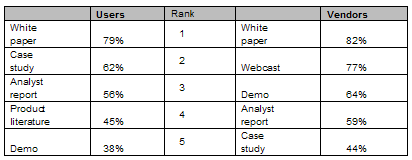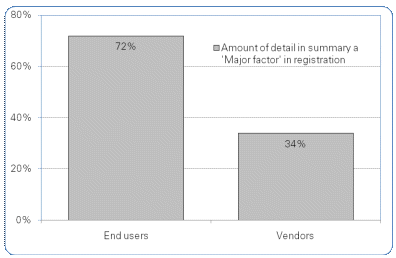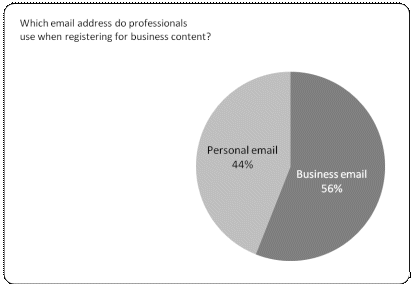Creating the right content products to support a marketing strategy is the first step in reaching out to potential customers online. The next step is just as important: deciding where to distribute that content, how to get users to engage with it and determining what information to collect from them in exchange.
“If you’re using content for a marketing goal, you want to make sure that users are finding it and that when they’re asked to register for it, they’re finding the experience is a good one,” says Matt Lohman, Director, Business Development for content syndicator KnowledgeStorm.
Those challenges were the focus of a survey conducted in April 2007 by MarketingSherpa and KnowledgeStorm. We asked 427 marketers and 2,394 content users registered in KnowledgeStorm’s database questions about how they distribute and access content online, as well as what factors influence their decision to register to get it. It’s the second part of a three-stage study into online content creation, distribution and performance measurement. (See the hotlink below for our take on the results from the first part of the survey.)
The complete survey results will be available at KnowledgeStorm’s website in two weeks. But here’s an early look at three insights into vendors’ and end users’ opinions on key issues related to the online content registration process:
Table: What Content Is Worthy of Registration? Copyright 2007: KnowledgeStorm Inc. All rights reserved
Copyright 2007: KnowledgeStorm Inc. All rights reservedWhen most vendors think of content with a marketing potential, they think of white papers, webcasts and webinars and case studies. That’s a safe bet, as users mostly agree with the assessment and are willing to register to get those materials.
But as the table above shows, nearly half of the end users are willing to register to receive product literature, such as product terminology, capabilities and pricing information. Yet, when vendors were asked what was worthy of requiring registration, product literature didn’t crack the top five. In fact, only 19% of vendors said they thought it should be put behind a registration barrier.
Most vendors probably have this information somewhere on their websites. But if you’re not putting it in a portable format, such as a PDF, you could be missing an opportunity to gather more registrations from customers and prospects. The trick is to make sure it’s thorough and well organized, so its quality is on par with the other marketing-related content you produce.
On the other hand, end users weren’t as keen on webcasts as marketers. Only 31% of users (rank: #7) said they were typically willing to register for a webcast, even though registration is almost always mandatory for such events.
There could be two reasons for this discrepancy. First, the term webcast can mean different things to different people, and survey respondents may have been thinking primarily of live, online events rather than on-demand, recorded webinars.
Second, Lohman says the KnowledgeStorm audience is used to searching the site for content they can access immediately and use in a portable format. Even though KnowledgeStorm’s network supports registration for live Web events, response from users is typically lower for those events than the response to white papers or other products.
Archived or on-demand webinars do better than live events in the KnowledgeStorm network, but still don’t generate as much interest as, say, a white paper or case study. So, if you’re a marketer trying to syndicate a webcast or webinar, one approach that could capture more registrations is to create an event transcript after the fact that users can download and read on their own time.
Chart: Will a Detailed Summary Encourage Registration? Copyright 2007: KnowledgeStorm Inc. All rights reserved
Copyright 2007: KnowledgeStorm Inc. All rights reservedHere’s another case in which end users and vendors have different expectations. We asked both groups what factors are most important when deciding to register for a piece of content. Choices included factors such as the source of the material, the type of content and the length of the content.
What’s most telling was the discrepancy between the two groups’ opinions on importance of having a detailed summary of the material they had receive. Nearly three-quarters of end users said having that was a ‘major factor’ in their decision to register vs only 34% of vendors.
Users are very selective about the content they will register for, so it shouldn’t be surprising that providing enough detail to make an informed decision is important. But it appears that vendors don't pay as much attention to this factor as they should. Take a look at the summary information you’re providing for your content and ask yourself if it will satisfy users’ need to know what they’re getting.
Chart: How Often Do You Provide Valid Registration Information? Copyright 2007: KnowledgeStorm Inc. All rights reservedChart: Use of Business Email Address vs Personal Email Address When Registering for Content
Copyright 2007: KnowledgeStorm Inc. All rights reservedChart: Use of Business Email Address vs Personal Email Address When Registering for Content Copyright 2007: KnowledgeStorm Inc. All rights reserved
Copyright 2007: KnowledgeStorm Inc. All rights reservedThe first of these two charts should comfort vendors who use a content marketing strategy: 72% of users said they always provide a valid name when registering for content, and 68% said they always give a valid email address.
But look at the types of email address being submitted: 44% said they use a personal email account, such as Gmail, Yahoo! or Hotmail. Vendors often view such addresses as less qualified when analyzing responses to their content registrations, yet a business exec may want to use a personal account for several reasons, such as the desire to reduce clutter in their business inbox.
Since more than two-thirds of users said they always give a valid email address, don’t automatically discount those Hotmail or Yahoo! accounts.
Useful links related to this articleNew Research Data: What Content Do B-to-B Customers, Prospects Yearn to Read?
http://www.marketingsherpa.com/article.php?ident=29888
KnowledgeStorm report:
http://www.knowledgestorm.com/connectingthroughcontent













